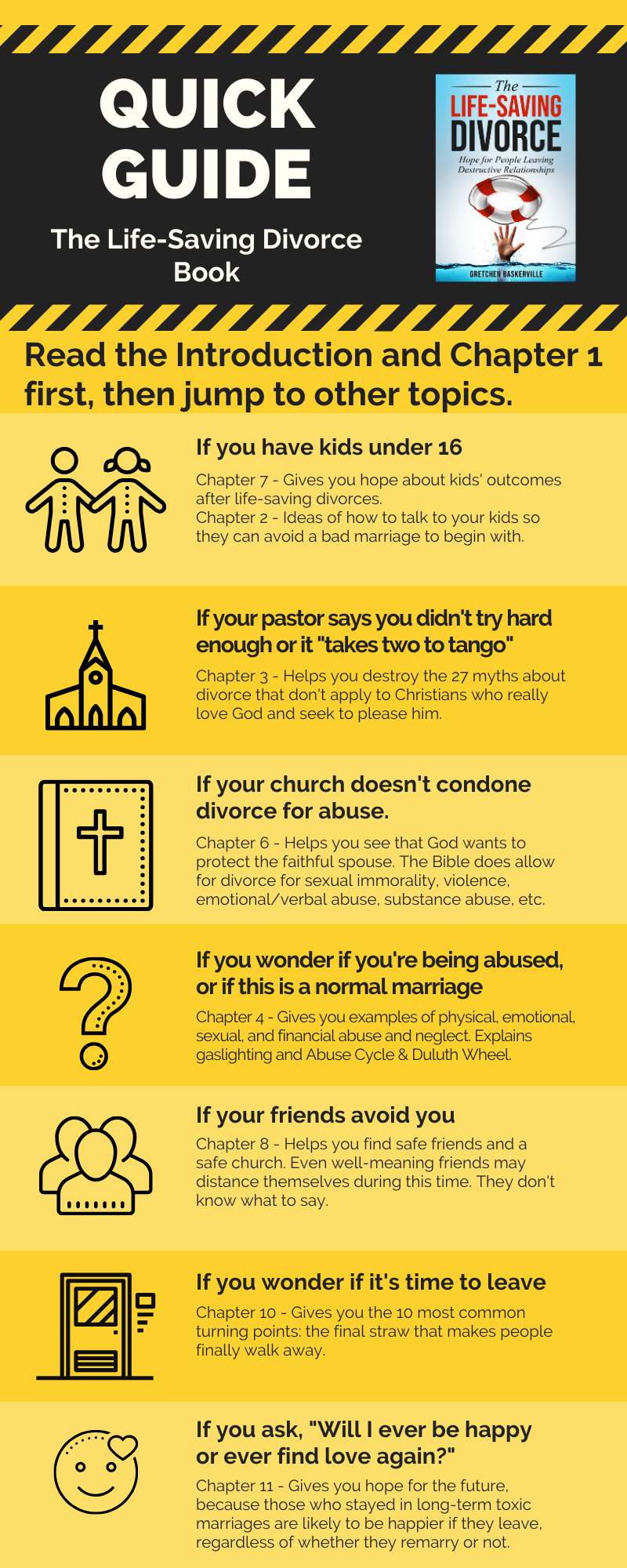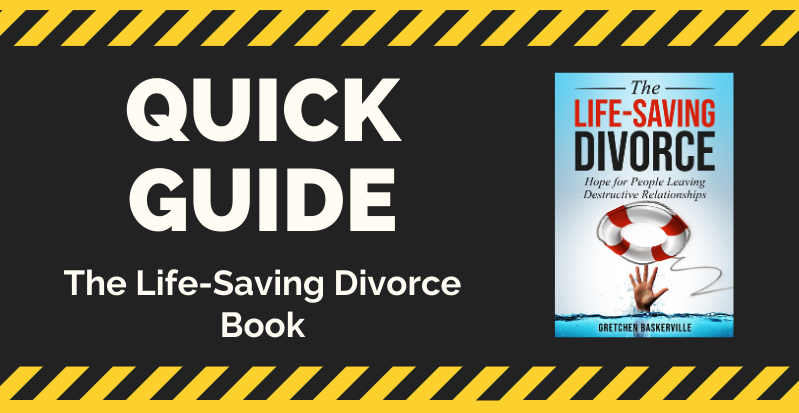Table of Contents
Link to the book on Amazon: https://amzn.to/3CCBsnr
Acknowledgments
Chapter 1: What Is a Life-Saving Divorce?
Nearly half of divorces are life-saving divorces: those marriages with serious problems (adultery, physical abuse, emotional abuse, drug/alcohol addictions, or sexual immorality). As a divorce recovery leader, for the past 20 years I’ve listened to heart-breaking stories of good spouses who tried to hold their marriage together at all costs.
Chapter 2: Understanding Divorce and Dangerous Marriages
How did I get into this? How many dangerous marriages are there? Are abuse, infidelity, and addictions common? And how do I keep my children from getting into bad marriages? What role do age and education play? How do social and religious pressures (such as legalism) affect marriage quality? Why is the divorce rate declining? How does no-fault divorce affect the rates of suicide and domestic violence?
Chapter 3: Myths of Divorce—Did I Try Hard Enough?
Most good spouses tried very hard to make their marriage work. They gave it their all. Here’s how to respond to 27 myths: false messages such as, “it takes two to tango,” “marriage problems are always 50/50,” or “it’s best to stay for the kids.” This chapter also addresses religious messages such as, “obviously you don’t care about the sanctity of marriage,” “you don’t take the Word of God seriously,” or “you must forgive and forget.”
Chapter 4: Am I Being Abused?
This chapter helps you figure out: “Is it abuse, or is this a difficult marriage with normal ups and downs?” Some people are confused; they feel scared even though they’ve never been physically struck. Here are 100 examples of physical, emotional, sexual, spiritual, and financial abuse, including explanations of terms like “gaslighting,” “the abuse cycle,” and featuring the Duluth Wheel of Power and Control diagram.
Chapter 5: To Stay, or To Go?
How do you know if it’s time to go? Learn about 10 common tipping points, those “Aha” moments when people sense it is time to leave. Only you know what you can take, and only you know when “enough is enough.” Learn the steps for protecting yourself using “safe words,” plus 50 tips to prepare yourself financially, physically, and legally to get away and get to safety.
Chapter 6: What Does the Bible Say?
God cares about and protects vulnerable spouses. The Bible says there are several acceptable reasons for divorce: infidelity, physical abuse, emotional abuse, sexual immorality, neglect, and abandonment. This chapter includes key Bible verses as we look at the teachings of Jesus, the apostle Paul, and Moses, as well as the Jewish customs and culture in biblical times.
Chapter 7: Raising Kids After Divorce
About 8 in 10 children of divorced parents have no serious longterm social, emotional, or psychological problems. More than 9 in 10 have no drug or alcohol problems. Is divorce hard on them? Yes, of course. But if you are in a high-distress marriage, even if there’s no screaming, fist-pounding, or overt conflict, it is likely better for your children that you divorce rather than stay in a tension-filled home where you’re all walking on eggshells.
This chapter also discusses kids in high-conflict, vengeful divorces. About 1 in 10 divorces is not normal; it involves a hostile ex-spouse (perhaps a narcissist or sociopath) who attacks with vitriol, threats, name-calling, multiple court appearances, stalking, false accusations with no evidence, parental alienation, or years of child custody battles. Learn how to parent your children in these situations, and how to document your ex’s behavior so you can protect yourself better.
Chapter 8: Safe Churches and Friends
Nearly 1 in 3 churchgoing Christians who divorce switch to another church during the process. They love God, but they worry about judgment and gossip. Safe friends and a safe religious fellowship can be an encouragement. When you go through a divorce, some good friends may walk away, or they want to cast judgment on you. It’s good to find supportive people who’ve walked in your shoes. This chapter helps you identify pastors and friends who are safe.
Chapter 9: Male Victims of Abuse and Betrayal
For every seven women who are abused, there is at least one man. In this chapter, we look at the stories of two men’s life-saving divorces from wives who were abusive or adulterous. They explain what kept them in these long marriages and how they finally realized it was over. Men often feel shame about being abuse victims; they deserve to be heard, cared for, and understood.
Chapter 10: Moving On: Finding Happiness Again
Although those first two or three years are stressful, you can survive! Shock, anger, fear, worry, and loneliness are part of the process. Recovering from trauma takes time. Know how to rebuild your self-respect and find your separate identity. Find your voice and become better at protecting yourself and your kids. Discover why those who get life-saving divorces are likely to be happier than if they had stayed—whether they remarry or decide to stay single.
Index
About the Author
Buy the book (paperback or ebook) on Amazon: https://amzn.to/3CCBsnr

For more on the myths of divorce, buy the Life-Saving Divorce.
As an Amazon Associate I earn from qualifying purchases.

